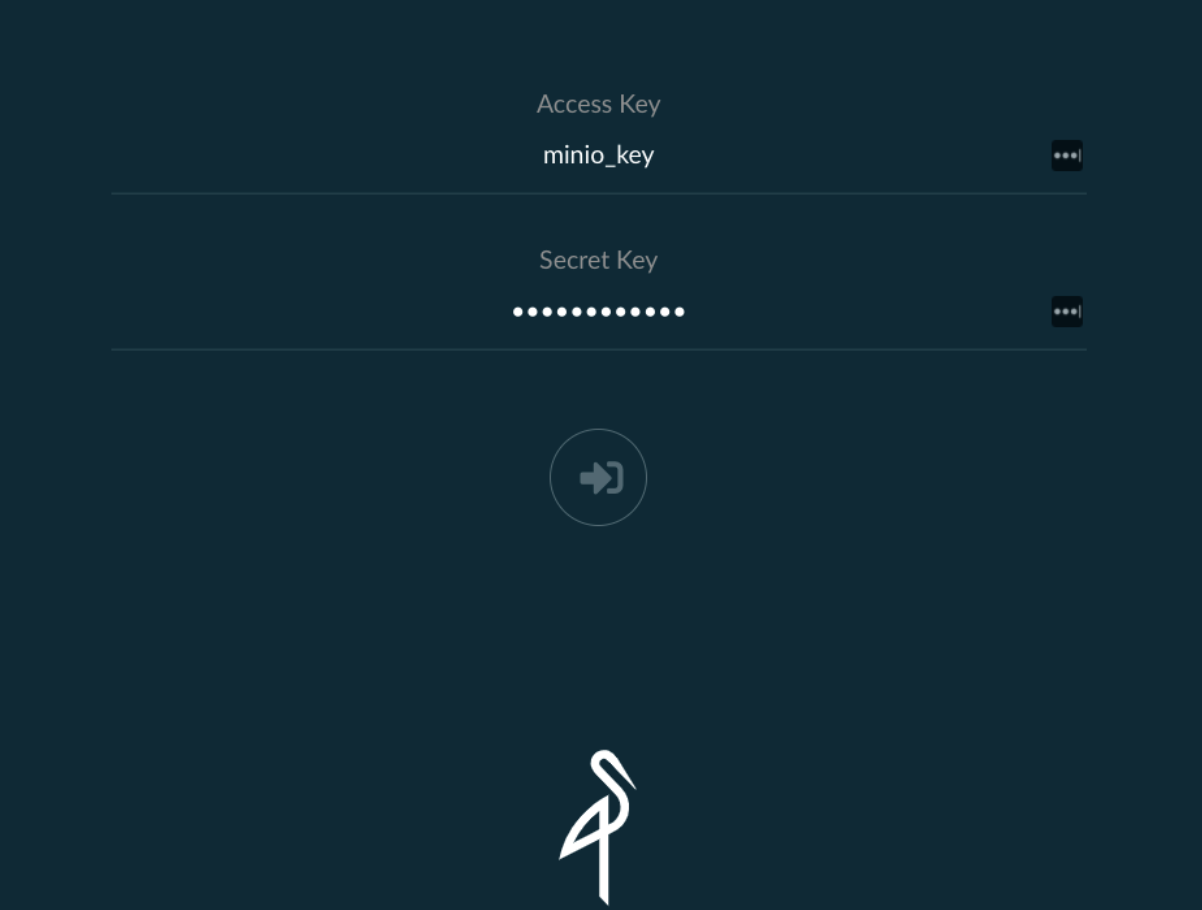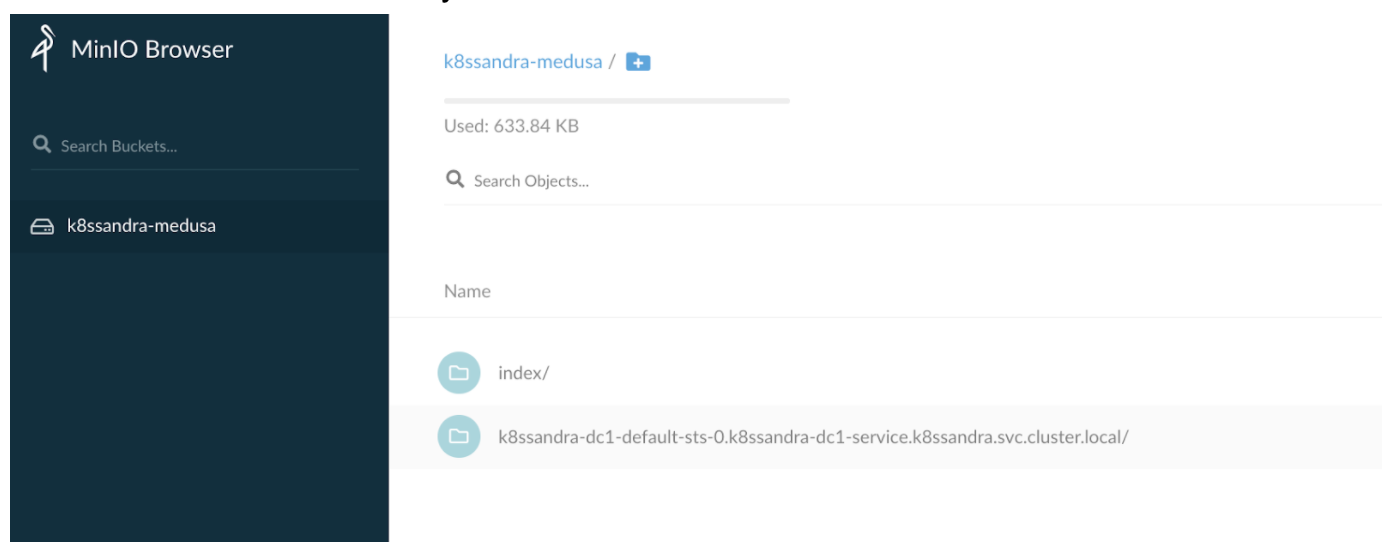Backup and restore Cassandra with MinIO
Medusa recently introduced support for all S3-compatible backends, including MinIO. This feature is included in K8ssandra 1.1.0 and later releases.
MinIO is a popular Kubernetes object storage suite. This topic walks you through the backup and restore steps.
For related information, see Backup and restore Cassandra with Amazon S3.
Deploy MinIO
Deploy MinIO through Helm. First, add the MinIO repository to your local list:
helm repo add minio https://helm.min.io/
The MinIO Helm charts allow you to do several things at once at install time:
- Set the credentials to access MinIO
- Create a bucket for your backups that can be set as the default
For example, to create a k8ssandra-medusa bucket, use minio_key/minio_secret as the credentials, and deploy MinIO in a new namespace called minio :
helm install --set
accessKey=minio_key,secretKey=minio_secret,defaultBucket.enabled=true,defaultBucket.name=k8ssandra-medusa
minio minio/minio -n minio --create-namespace
Tip
Creating the bucket is not mandatory at this stage; alternatively, you can create the bucket via the MinIO UI.After the helm install command has completed, you’ll see messages similar to the following in the minio namespace:
kubectl get all -n minio
Output:
NAME READY STATUS RESTARTS AGE
pod/minio-5fd4dd687-gzr8j 1/1 Running 0 109s
NAME TYPE CLUSTER-IP EXTERNAL-IP PORT(S) AGE
service/minio ClusterIP 10.96.144.61 <none> 9000/TCP 109s
NAME READY UP-TO-DATE AVAILABLE AGE
deployment.apps/minio 1/1 1 1 109s
NAME DESIRED CURRENT READY AGE
replicaset.apps/minio-5fd4dd687 1 1 1 109s
Using port forwarding, you can expose access to the MinIO UI in the browser on port 9000:
kubectl port-forward service/minio 9000:9000 -n minio
Output:
Forwarding from 127.0.0.1:9000 -> 9000
Forwarding from [::1]:9000 -> 9000
Now you can login to MinIO at http://localhost:9000 using your install-time defined credentials.

Once logged in, you can see that the k8ssandra-medusa bucket was created and is currently empty:

Deploy K8ssandra
Now that MinIO is up and running, you can create a namespace for your K8ssandra installation and create a secret for Medusa to access the bucket. Create a medusa_secret.yaml file with the following content:
apiVersion: v1
kind: Secret
metadata:
name: medusa-bucket-key
type: Opaque
stringData:
# Note that this currently has to be set to medusa_s3_credentials!
medusa_s3_credentials: |-
[default]
aws_access_key_id = minio_key
aws_secret_access_key = minio_secret
Now create the k8ssandra namespace and the Medusa secret with the following commands:
kubectl create namespace k8ssandra
kubectl apply -f medusa_secret.yaml -n k8ssandra
You should now see the medusa-bucket-key secret in the k8ssandra namespace:
kubectl get secrets -n k8ssandra
Output:
NAME TYPE DATA AGE
default-token-twk5w kubernetes.io/service-account-token 3 4m49s
medusa-bucket-key Opaque 1 45s
You can then deploy K8ssandra with the following custom values YAML file; all default values will be used if not customized. Save the following content in a values file named (for example) k8ssandra_medusa_minio.yaml:
medusa:
enabled: true
storage: s3_compatible
storage_properties:
host: minio.minio.svc.cluster.local
port: 9000
secure: "False"
bucketName: k8ssandra-medusa
storageSecret: medusa-bucket-key
Then install K8ssandra and specify the values file above with the following command:
helm install k8ssandra k8ssandra/k8ssandra -f k8ssandra_medusa_minio.yaml -n k8ssandra
Now wait for the Cassandra cluster to be ready by using the following wait command:
kubectl wait --for=condition=Ready cassandradatacenter/dc1 --timeout=900s -n k8ssandra
When ready, you should now see a list of pods. Example:
kubectl get pods -n k8ssandra
Output:
NAME READY STATUS RESTARTS AGE
k8ssandra-cass-operator-547845459-dwg68 1/1 Running 0 6m36s
k8ssandra-dc1-default-sts-0 3/3 Running 0 5m56s
k8ssandra-dc1-stargate-776f88f945-p9twg 0/1 Running 0 6m36s
k8ssandra-grafana-75b9cb64cc-kndtc 2/2 Running 0 6m36s
k8ssandra-kube-prometheus-operator-5bdd97c666-qz5vv 1/1 Running 0 6m36s
k8ssandra-medusa-operator-d766d5b66-wjt7j 1/1 Running 0 6m36s
k8ssandra-reaper-5f9bbfc989-j59xk 1/1 Running 0 2m48s
k8ssandra-reaper-operator-858cd89bdd-7gfjj 1/1 Running 0 6m36s
k8ssandra-reaper-schema-4gshj 0/1 Completed 0 3m3s
prometheus-k8ssandra-kube-prometheus-prometheus-0 2/2 Running 1 6m32s
Create some data and back it up
Next, let’s define some sample data in Cassandra by creating a test_data.cql file that contains DDL and DML statements:
CREATE KEYSPACE medusa_test WITH replication = {'class': 'SimpleStrategy', 'replication_factor': 1};
USE medusa_test;
CREATE TABLE users (email text primary key, name text, state text);
insert into users (email, name, state) values ('[email protected]', 'Alice Smith', 'TX');
insert into users (email, name, state) values ('[email protected]', 'Bob Jones', 'VA');
insert into users (email, name, state) values ('[email protected]', 'Carol Jackson', 'CA');
insert into users (email, name, state) values ('[email protected]', 'David Yang', 'NV');
Copy the CQL file into the Cassandra pod; that is, the StatefulSet one, which contains -sts- in its name:
kubectl cp test_data.cql k8ssandra-dc1-default-sts-0:/tmp -n k8ssandra -c cassandra
Now extract the password to access Cassandra with the k8ssandra-superuser. (The password is different for each installation unless it is explicitly set at install time.)
kubectl get secret k8ssandra-superuser -n k8ssandra -o jsonpath="{.data.password}" | base64 --decode ; echo
Output:
XHsZ943WBg5RPNhVAT8x
Tip
The password above is an example. The value will be different for your environment. In the subsequent examples, don’t forget to replace the sample password with the one extracted in your environment.Let’s now run the uploaded cql script and check that you can read the data.
kubectl exec -it k8ssandra-dc1-default-sts-0 -n k8ssandra -c cassandra -- cqlsh -u k8ssandra-superuser -p XHsZ943WBg5RPNhVAT8x -f /tmp/test_data.cql
kubectl exec -it k8ssandra-dc1-default-sts-0 -n k8ssandra -c cassandra -- cqlsh -u k8ssandra-superuser -p XHsZ943WBg5RPNhVAT8x -e "SELECT * FROM medusa_test.users"
Output:
email | name | state
-------------------+---------------+-------
[email protected] | Alice Smith | TX
[email protected] | Bob Jones | VA
[email protected] | David Yang | NV
[email protected] | Carol Jackson | CA
(4 rows)
Now backup this data, and check that files get created in your MinIO bucket.
helm install my-backup k8ssandra/backup -n k8ssandra --set name=backup1,cassandraDatacenter.name=dc1
Because the backup operation is asynchronous, you can monitor its completion by running the following command:
kubectl get cassandrabackup backup1 -n k8ssandra -o jsonpath={.status.finishTime}
As long as this command doesn’t output a date and time, you know that the backup is still running. With the amount of data present and the fact that you’re using a locally accessible backend, this should complete quickly.
Now refresh the MinIO UI and you should see some files in the k8ssandra-medusa bucket:

In the MinIO UI, we now see an index folder, which is the Medusa backup index, and another folder that is specific to each Cassandra node in the cluster. In this example, there is only one node.
Deleting the data and restoring the backup
Now delete the data by truncating the table, and check that the table is empty.
kubectl exec -it k8ssandra-dc1-default-sts-0 -n k8ssandra -c cassandra -- cqlsh -u k8ssandra-superuser -p XHsZ943WBg5RPNhVAT8x -e "TRUNCATE medusa_test.users"
kubectl exec -it k8ssandra-dc1-default-sts-0 -n k8ssandra -c cassandra -- cqlsh -u k8ssandra-superuser -p XHsZ943WBg5RPNhVAT8x -e "SELECT * FROM medusa_test.users"
Output:
email | name | state
-------+------+-------
(0 rows)
Now restore the backup taken previously:
helm install restore-test k8ssandra/restore --set name=restore-backup1,backup.name=backup1,cassandraDatacenter.name=dc1 -n k8ssandra
The restore operation will take a little longer because it requires K8ssandra to stop the StatefulSet pod and perform the restore as part of the init containers, before the Cassandra container can start. You can monitor progress using this command:
watch -d kubectl get cassandrarestore restore-backup1 -o jsonpath={.status} -n k8ssandra
The restore operation is fully completed once the finishTime value appears in the output. Example:
{"finishTime":"2021-03-30T13:58:36Z","restoreKey":"83977399-44dd-4752-b4c4-407273f0339e","startTime":"2021-03-30T13:55:35Z"}
Verify that you can now read the restored data from the previously truncated table:
kubectl exec -it k8ssandra-dc1-default-sts-0 -n k8ssandra -c cassandra -- cqlsh -u k8ssandra-superuser -p XHsZ943WBg5RPNhVAT8x -e "SELECT * FROM medusa_test.users"
Output:
email | name | state
-------------------+---------------+-------
[email protected] | Alice Smith | TX
[email protected] | Bob Jones | VA
[email protected] | David Yang | NV
[email protected] | Carol Jackson | CA
(4 rows)
Success! You’ve successfully restored your lost data in just a few commands.
Next steps
An alternative to MinIO buckets is Amazon S3. See Backup and restore Cassandra with Amazon S3.
Also see the following reference topics:
Feedback
Was this page helpful?
Glad to hear it! Please tell us how we can improve.
Sorry to hear that. Please tell us how we can improve.